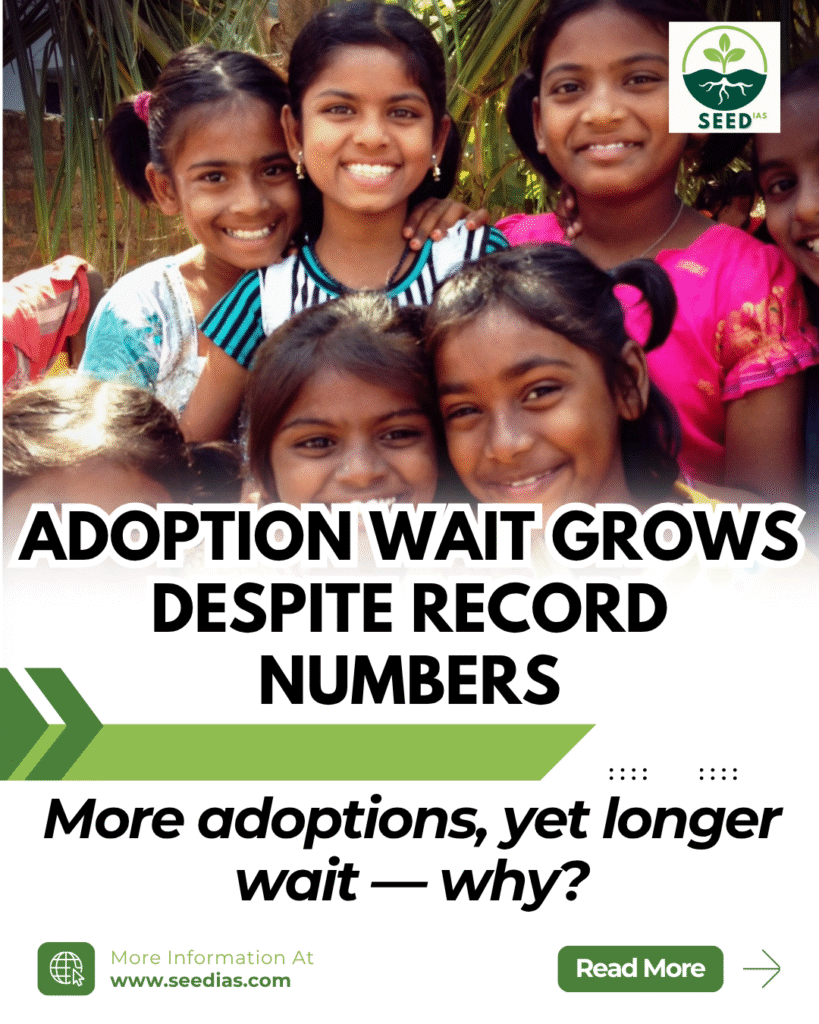Why in NEWS
The Central Adoption Resource Authority (CARA) is struggling to address the widening gap between adoptable children and prospective adoptive parents, leading to delays. The average waiting period for adoption referrals has increased to 3.5 years in 2025, up from 3 years in 2022.
KEY CONCEPTS/TERMS
| Term | Explanation |
|---|---|
| CARA | Statutory body under the Ministry of Women & Child Development regulating and monitoring adoptions in India. |
| JJ Act, 2015 | Governs adoption for all citizens irrespective of religion. Mandates CARA registration and Home Study Reports. |
| HAMA, 1956 | Allows adoption for Hindus, Buddhists, Jains, and Sikhs. Not monitored by CARA. |
| HSR | Home Study Report prepared by a Specialised Adoption Agency to assess prospective parents. |
| Hague Convention (1993) | Governs intercountry adoption with legal and ethical safeguards. India ratified in 2003. |
| PAPs | Prospective Adoptive Parents registered with CARA. |
| SAAs | Specialised Adoption Agencies certified by CARA to process adoptions. |
| SARA/DCPU/CWC | State and district-level authorities implementing adoption policies. |
CURRENT STATUS OF ADOPTION IN INDIA
| Feature | Details |
|---|---|
| Adoptions (2024–25) | 4,515 total; 4,155 were domestic adoptions—the highest since 2015. |
| Waiting Period | Increased to 3.5 years in 2025 from 3 years in 2022. |
| Child Preference | 80% adopted are aged 0–2 years; 60% are girls. |
| Laws Involved | Governed under HAMA (1956) and JJ Act (2015). |
| International Oversight | Hague Convention ensures inter-country adoption safeguards. |
| CARA’s Role | Regulates both domestic and international adoptions, manages CARINGS portal. |
KEY CHALLENGES IN THE ADOPTION PROCESS
| Challenge | Explanation |
|---|---|
| Demand–Supply Gap | Ratio of PAPs to adoptable children is 13:1; only a fraction of institutionalised children are legally free for adoption. |
| Implementation Gaps | Poor inter-agency coordination, absentee guardians, weak training, and legal loopholes delay adoptions. |
| Legal Duality | HAMA is quick but lacks regulation; JJ Act is slow but transparent—creates confusion and delays. |
| Age Mismatch | 34% of adoptable children are above 14; but most parents want infants. |
| High Returns | Between 2017–19, 60% of returned children were girls; others had special needs or were above 6 years. |
| LGBTQ+ Exclusion | No legal provision for same-sex couples; leads to informal and often unsafe adoption practices. |
MEASURES TAKEN TO IMPROVE ADOPTION SYSTEM
| Measure | Description |
|---|---|
| Child Pool Expansion (2023) | Added children from CCIs under 5 categories: Orphan, Abandoned, Surrendered, No Visitation, and Unfit Guardianship. |
| Digital Reforms | Enhanced CARINGS portal with faster workflows for relative and step-parent adoptions. |
| Mandatory Counselling (2025) | Counselling made compulsory before, during, and after adoption for both child and parents. |
RECOMMENDED STEPS FOR FUTURE REFORM
| Step | Description |
|---|---|
| Child-Centric Policy | Shift focus from PAP preference to child’s right to family and care, aligned with UNCRC principles. |
| Simplified Procedures | Digitise and integrate processes under JJ Act and CARA with time-bound clearances and dedicated officers. |
| Psychosocial Support | Deploy trained counsellors to aid bonding and reduce child returns. |
| Awareness Campaigns | Use IEC strategies to remove stigma, promote adoption of older and special needs children. |
IN A NUTSHELL (Memory Code: CARA-GAP)
- C – Counselling made mandatory
- A – Adoption pool expanded via CCIs
- R – Regulatory duality: JJ Act vs HAMA
- A – Age bias delays adoption
- G – Gap between PAPs and children (13:1)
- A – Awareness to destigmatise non-biological parenting
- P – Processing time reforms via digital portals
PRELIMS PRACTICE QUESTIONS
- Which of the following is NOT regulated by the Central Adoption Resource Authority (CARA)?
A. Inter-country adoptions
B. Step-parent adoptions
C. Hindu Adoptions under HAMA
D. Specialised Adoption Agencies - Consider the following statements regarding the Juvenile Justice Act, 2015:
1. It allows adoption by any Indian citizen irrespective of religion.
2. It mandates registration on the CARA portal for all adoptions.
Which of the statements is/are correct?
A. 1 only
B. 2 only
C. Both 1 and 2
D. Neither 1 nor 2 - The Hague Convention on Intercountry Adoption (1993):
A. Is mandatory only for adoption between developed countries
B. Was signed by India in 2003
C. Allows informal adoptions
D. Applies only to biological parents
MAINS PRACTICE QUESTIONS
- “Despite legal safeguards, the adoption process in India remains exclusionary and inefficient.” Discuss in light of recent challenges and reforms. 10 Marks (GS2 – Polity & Governance)
- Examine the role of CARA in promoting ethical and transparent adoptions. Suggest measures to ensure inclusivity and timeliness in the adoption process. 10 Marks (GS2 – Welfare Schemes)
PRELIMS ANSWER KEY
| Q No. | Answer | Explanation |
|---|---|---|
| 1 | C | HAMA adoptions are not regulated by CARA. |
| 2 | A | JJ Act allows adoption by all citizens, but HAMA adoptions are exempt from CARA portal registration. |
| 3 | B | India ratified the Hague Convention on Intercountry Adoption in 2003. |
















